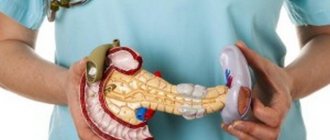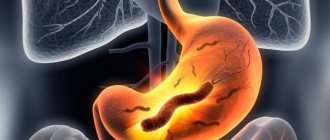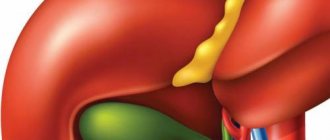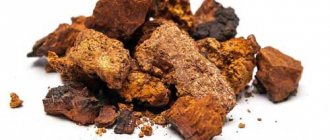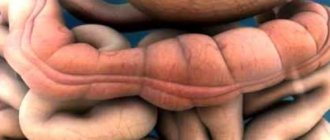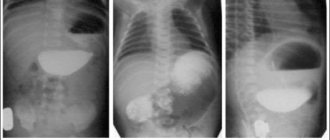Pylorospasm is a spasmodic phenomenon in the stomach at the point of its exit into the duodenum. The disease is characterized by vegetative dystonia; in children it often goes away on its own after the nervous system matures. This condition is most dangerous in infancy, when excessive vomiting can cause severe dehydration of the child’s body. Pylorospasm in children and newborns responds well to treatment with diet and medication.
Causes of pylorospasm
In most cases, several factors are involved in the occurrence of pylorospasm: lack of vitamins, increased neuro-reflex effects on the pylorus. In infancy and early childhood, the disease occurs more often in boys. The exact reasons for its appearance have not been established.
In newborns, the development of the disease may be preceded by:
- fetal hypoxia;
- congenital malformation;
- birth injury;
- immaturity of the central nervous system;
- functional disorder of the digestive glands;
- prematurity, especially deep.
In children over one year old and adolescents, pylorospasm may occur due to the following unfavorable factors:
- general intoxication of the body with toxic substances - nicotine, morphine, and so on;
- lack of vitamins;
- physical, emotional exhaustion;
- damage to the central nervous system.
Why does pylorospasm occur?
Between the stomach and duodenum there is a narrow muscular part - the pylorus. It contains a ring-shaped layer of muscle that forms the sphincter. After food is digested in the stomach, it passes into the intestines, where the pH of the environment changes from acidic to alkaline. The food cannot be returned, otherwise it will have a bad effect on the acidity of the stomach.
Pylorospasm in a newborn is a functional disorder
Symptoms and signs of the disease in children
The appearance of symptoms begins from the very first days of the development of spasm:
- Compensated stage. Food has difficulty passing through the narrowed opening. This is manifested by nausea, a feeling of heaviness in the hypochondrium, colicky pain in the gastric region, and less commonly, vomiting. In infants who eat mainly liquid foods, the spasm may not be as pronounced. After one year of age, children experience all of the above symptoms.
- Stage of decompensation. The patency of the stomach in the pyloric area is impaired, the pain becomes constant: aching or paroxysmal. After eating, vomiting often occurs, and the vomit may have a “rotten” smell. Against this background, the quality of sleep deteriorates, weight loss, dehydration, and exhaustion occur. At an early age, this condition of the child is extremely dangerous due to the small body weight.
In the initial stage, pylorospasm in newborns manifests itself as frequent vomiting, sometimes in a fountain, especially in the first minutes after eating. Vomiting can occur even from a few grams of milk, and the amount of vomit will be several times greater. You should also pay attention to constant crying, anxiety, poor sleep, constipation, twitching of the abdominal muscles due to spasms, and lethargy.
Older children may complain of abdominal or side pain, have poor appetite, or draw their legs toward their stomach while sleeping.
Symptoms
Most often, symptoms of pylorospasm appear immediately after birth. A few breastfeedings are enough to detect problems with milk absorption. In rare cases, the disease is diagnosed not in newborns, but in infants under the age of 1 year. The signs of pathology have their own characteristics.
It is difficult for parents to independently identify the symptoms of pathology, so it is advisable that the newborn be under the supervision of a doctor at first. Although the main signs of pylorospasm are considered to be excessive regurgitation and periodic vomiting, they develop gradually.
First, symptoms appear such as loose stools, bloating, colic, in which the child is capricious and does not allow his tummy to be touched. Over time they develop:
- poor weight gain – the child’s body weight does not reach normal levels;
- excessive regurgitation after each feeding, parents get the impression that all the food they have taken is coming out;
- restlessness, moodiness, frequent crying;
- sleep disorders;
- constipation;
- pale skin, lack of interest, apathy.
In newborns, pylorospasm of the primary form is more often diagnosed - the pathology develops independently.
In infants and older children who did not have pyloric spasm at birth, a secondary form of pathology develops. It is provoked by diseases of other gastrointestinal organs. In this case, the symptoms are similar, but all signs of disturbances in the work of the pylorus develop more intensively, complications arise:
- body weight deficiency reaches critical levels;
- profuse vomiting occurs more and more often;
- due to constant constipation and vomiting, diseases of the digestive system develop, associated with stagnation of feces and inflammatory processes.
Sometimes pylorospasm in infants can be congenital, but due to mild symptoms, it begins to appear months later in the child’s life.
Types of pylorospasm
Depending on the age at which the disease first occurs and the conditions of its occurrence, pylorospasm is usually divided into primary and secondary. Primary manifests itself more often in infancy, sometimes even in the first weeks of a child’s life, under the influence of unfavorable factors:
- disruptions in the functioning of the central nervous system, as a result of which the functioning of the pyloric part of the stomach is disrupted;
- vitamin deficiency (especially lack of B vitamins) and insufficient intake of minerals into the body;
- low levels of gastrointestinal hormones;
- disruption of the production of digestive secretions.
Secondary pylorospasm in children develops against the background of an underlying disease:
- gastritis;
- ulcer;
- stomach polyps;
- Crohn's disease;
- cholecystitis;
- duodenitis;
- as a result of the formation of adhesions after surgery on the stomach.
Symptoms, diagnosis and treatment of pyloric spasm in newborns and young infants
Often, the symptoms of this disease can be identified from the moment the child is born. In rare cases, diagnosis and treatment can take up to several months.
The main signs may not be noticed by parents at first, since newly born children often have problems with bloating, infrequent bowel movements, and colic.
Also, young children burp very often, so it is necessary to consider all the symptoms of the disease in a complex manner.
Main features:
- Excessive regurgitation or vomiting after each feeding. The volume of regurgitation on average exceeds 2 tablespoons.
- Poor weight gain
- Sleep disturbance
- General restlessness, frequent crying
- Colic
- Rare urination
- Constipation
- Pale, tired look
Symptoms of pyloric spasm in infants can be divided into two stages:
- Compensated form. Its peculiarity is that the sphincter of the pyloric part of the stomach is narrowed, but food can enter the duodenum through a small opening.
- Decompensated form. The pyloric muscles are completely closed and food cannot enter the intestines. In this case, vomiting occurs or stagnant digested food undergoes putrefactive processes.
Pylorospasm can be either primary or secondary. In the first case, the symptoms of the disease arise due to the malfunction of the gatekeeper itself. In the second case, the illness is a consequence of another disease and is subject to complex treatment.
Many doctors classify this disease according to the method of removing food remaining in the stomach:
- The spastic form is characterized by the removal of food from the stomach through severe vomiting, often of a gushing nature.
- The atonic form does not have such pronounced signs; food flows out of the child’s mouth gradually.
Pylorospasm is not a serious disease and, if timely measures are taken, does not cause any consequences in children.
Diagnosis of the disease
Diagnosis and treatment of the disease is carried out by a pediatric gastroenterologist. In addition to the usual examination, differential diagnosis is also prescribed, which includes contrast radiography.
When administering a substance to a child, you can check how long the food remains in the stomach. Usually this study is sufficient to make a diagnosis. In extreme cases, endoscopy, ultrasound, CT, and FGDS are prescribed.
The task of the gastroenterologist is to distinguish pylorospasm from other diseases in which vomiting and other similar symptoms may occur: intestinal infection, meningitis, pneumonia, allergic reaction.
You should also not exclude other causes of excessive vomiting:
- Frequent overfeeding
- Esophageal stenosis
- Esophageal artesia
- Swallowing air during feeding
- Esophageal-tracheal fistula
- Congenital pathologies (for example, short esophagus)
Possible complications of pylorospasm
If left untreated, pyloric spasm leads to hypertrophy of the pyloric muscles, and subsequently to pyloric stenosis. During the neonatal period, the following complications are possible, which can even lead to death:
- a sharp decrease in the child’s body weight;
- electrolyte imbalance, dehydration;
- development of mineral and vitamin deficiency due to food rejection.
Older children also suffer from a lack of salts and minerals in the body due to frequent vomiting. Constipation that occurs can lead to dysbiosis - the development of pathogenic bacteria in the stomach. Metabolism is also disrupted, which can lead to poor digestibility of food, vitamin deficiency, and weight loss for the child.
Complications and prognosis
Lack of medical care at an early stage leads to chronic gastrointestinal diseases later in life. Late diagnosis of pylorospasm increases the risk of complications:
- developmental delay;
- Iron-deficiency anemia;
- rickets;
- aspiration of stomach contents, aspiration pneumonia.
Pylorospasm is a benign pathology that goes away with the maturation of the nervous and digestive systems. If you follow the doctor's recommendations, symptoms decrease by 4-6 months and, as a rule, completely disappear by one year.
In continuation of the topic, be sure to read:
- Rectal fissure: causes, symptoms and treatment of pathology
- Causes of bloating and increased gas formation, treatment methods
- More about hemorrhoids: causes, symptoms and treatment methods
- Rectal cancer: symptoms, stages, treatment and prognosis for life
- Worms in children: how do they manifest themselves and what drugs to treat them with?
- Irritable bowel syndrome: symptoms and treatments
- Details about the coprogram: preparation, conduct and interpretation of the analysis
- What to do if your child is constipated?
- What medications should I use for increased gas formation?
- Stomach ulcer: how is the pathology manifested and treated?
Be sure to read:
Psychological constipation in a child 2-4 years old: methods of overcoming
Which doctors should you contact if you suspect pylorospasm in a child?
Any symptoms of pylorospasm require a visit with the child to a gastroenterologist and an ultrasound or endoscopic examination of the stomach. Additionally, consultation with a surgeon and neurologist may be required.
A child, especially one under one year of age, should be shown to a pediatrician as soon as possible to determine the causes of regurgitation, poor weight gain, and spasms. If you are vomiting repeatedly, you should call an ambulance. In this case, the child will be indicated for hospitalization in a hospital.
Causes of the disease
The functional state of the child’s internal organs is determined by the maturity of the autonomic nervous system. If it is imperfect, the innervation (supply of nerves) of the pyloric muscles is disrupted. There is a malfunction in the functioning of the neuromuscular apparatus of the stomach. This leads to an untimely spasm of the pyloric region, so food is delayed and problems arise during the digestion process.
In addition to autonomic dysfunction, pylorospasm can occur in young children for the following reasons:
- perinatal encephalopathy;
- hyperexcitability syndrome;
- psychopathy;
- vitamin deficiencies.
The reasons for the appearance of this pathology in schoolchildren and adults are as follows:
- chronic diseases of the stomach and intestines with frequent exacerbations (gastritis with high acidity, gastric and duodenal ulcers, dysbacteriosis, biliary dyskinesia);
Pylorospasm in adults often occurs against the background of peptic ulcer disease
- deficiency of B vitamins;
- constant stress;
- physical overload;
- hysterical neurosis.
There are primary pylorospasm, which occurs from birth due to the immaturity of the autonomic nervous system, and secondary, formed against the background of some pathology.
Examination and diagnosis of the disease
Taking anamnesis (questioning parents):
- stool disorders;
- regurgitation frequency;
- volume of vomit, admixtures of blood or mucus in it;
- time of vomiting – before meals, after meals;
- child's behavior.
Inspection:
- mucous membranes, skin;
- weighing;
- palpation of the abdomen;
- reflex study.
Instrumental diagnostics:
- MRI, CT – images of stomach tissue to identify narrowing or thickening in the pylorus area;
- X-ray examination;
- gastroscopy;
- less often - ultrasound of the stomach.
Based on the data obtained, a final diagnosis is established. If pyloric stenosis is excluded and no other pathologies are identified, drug treatment or nutritional correction is prescribed.
Diagnostics
Since vomiting in a newborn can be associated with a number of other pathologies, in addition to examination, additional hardware examination methods are used for diagnosis. During an X-ray examination with a contrast agent, its retention in the stomach is noted, but not more than 12 hours.
In particularly difficult cases, other studies are also carried out - FGDS, ultrasound, CT.
First of all, the doctor has to differentiate pylorospasm from pyloric stenosis, which is also associated with the pathology of the pylorus and disrupts the passage of food through the digestive tract. The main manifestation of pyloric stenosis is also vomiting, but it appears later, in the second or third week after the birth of the baby.
The severity of the condition increases very quickly with pyloric stenosis: dehydration develops, the child loses weight. Additional diagnostic methods allow you to differentiate these two diagnoses.
Vomiting in a newborn can also be caused by:
- Overfeeding the child, but in this case the condition and well-being of the baby does not suffer, the child does not lag behind in weight.
- Aerophagia (increased swallowing of air during feeding) - an x-ray examination will reveal a significant amount of air in the stomach.
- Developmental anomaly in the form of shortening of the esophagus, confirmed by x-ray data.
- Congenital achalasia of the esophagus is insufficient relaxation of the esophageal sphincter due to a disorder of nervous regulation. Diagnosed by X-ray or FGDS.
- Another congenital pathology - narrowing or fusion of the lumen of the esophagus, the presence of an esophageal-tracheal fistula - is also diagnosed by x-ray.
Treatment of pylorospasm
For newborns with a mild form of pylorospasm, the following is indicated:
- Drink 1–2 teaspoons of alkaline mineral water before meals.
- Feeding in small portions, fractional.
- When breastfeeding, frequent breastfeeding is recommended; when artificial, selecting mixtures with thickeners (locust bean gum).
- Carry the baby in an upright position after feeding for 10–15 minutes.
- Frequently laying on the stomach.
Older children are prescribed a special diet. It includes food that is processed in a gentle way - boiled, stewed. The consumption of canned food, carbonated drinks, fried and fatty foods, and hot spices is limited. Fractional meals are prescribed - 5-6 times a day in small portions.
Drug treatment consists of taking the following drugs:
- antispasmodics – drotaverine, papaverine hydrochloride;
- H1-histamine receptor blockers;
- sedatives – tincture of valerian, motherwort;
- complex or B vitamins (thiamine);
- muscle relaxants – atropine sulfate, platiphylline hydroarate.
Treatment is aimed at relieving spasms and restoring normal functioning of the stomach.
Additionally, medications may be prescribed to restore intestinal microflora and water-alkaline balance. Treatment of the disease in infants is usually carried out in a hospital setting.
Prevention of pylorospasm
The main rule for preventing pylorospasm is regular examinations during pregnancy. Prevention of oxygen starvation of the fetus plays an important role.
After birth, the newborn's nutrition must be monitored with special care. Breastfeeding is recommended at the baby's request and in small doses. After feeding, you need to hold the baby upright (in a column), and then lay it on the tummy.
After one year, babies should be given healthy food, protected from nervous overload, physical and emotional fatigue. The child should grow up in a calm environment with an established routine of life and nutrition. Moderate physical activity is important.
